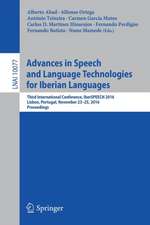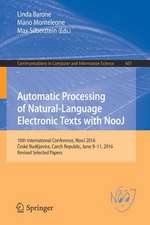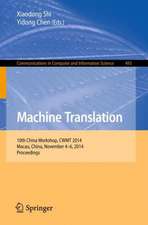An Introduction to Natural Language Processing Through Prolog: Learning about Language
Autor Clive Matthewsen Limba Engleză Hardback – 24 feb 2017
Following the general introduction, the first section of the book presents Prolog, and the following chapters illustrate how various Natural Language Processing programs may be written using this programming language. Since it is assumed that the reader has no previous experience in programming, great care is taken to provide a simple yet comprehensive introduction to Prolog. Due to the 'user friendly' nature of Prolog, simple yet effective programs may be written from an early stage. The reader is gradually introduced to various techniques for syntactic processing, ranging from Finite State Network recognisors to Chart parsers. An integral element of the book is the comprehensive set of exercises included in each chapter as a means of cementing the reader's understanding of each topic. Suggested answers are also provided.
An Introduction to Natural Language Processing Through Prolog is an excellent introduction to the subject for students of linguistics and computer science, and will be especially useful for those with no background in the subject.
| Toate formatele și edițiile | Preț | Express |
|---|---|---|
| Paperback (1) | 566.35 lei 6-8 săpt. | |
| Taylor & Francis – 10 iul 1998 | 566.35 lei 6-8 săpt. | |
| Hardback (1) | 764.20 lei 6-8 săpt. | |
| Taylor & Francis – 24 feb 2017 | 764.20 lei 6-8 săpt. |
Din seria Learning about Language
-
 Preț: 369.95 lei
Preț: 369.95 lei -
 Preț: 259.88 lei
Preț: 259.88 lei -
 Preț: 280.80 lei
Preț: 280.80 lei -
 Preț: 281.61 lei
Preț: 281.61 lei -
 Preț: 270.56 lei
Preț: 270.56 lei -
 Preț: 288.99 lei
Preț: 288.99 lei -
 Preț: 305.15 lei
Preț: 305.15 lei -
 Preț: 280.70 lei
Preț: 280.70 lei -
 Preț: 282.14 lei
Preț: 282.14 lei -
 Preț: 441.58 lei
Preț: 441.58 lei - 15%
 Preț: 566.35 lei
Preț: 566.35 lei -
 Preț: 310.22 lei
Preț: 310.22 lei -
 Preț: 484.69 lei
Preț: 484.69 lei -
 Preț: 216.03 lei
Preț: 216.03 lei -
 Preț: 469.34 lei
Preț: 469.34 lei -
 Preț: 374.58 lei
Preț: 374.58 lei - 18%
 Preț: 1000.27 lei
Preț: 1000.27 lei -
 Preț: 484.47 lei
Preț: 484.47 lei -
 Preț: 389.38 lei
Preț: 389.38 lei - 15%
 Preț: 564.21 lei
Preț: 564.21 lei -
 Preț: 450.40 lei
Preț: 450.40 lei -
 Preț: 347.91 lei
Preț: 347.91 lei - 15%
 Preț: 534.50 lei
Preț: 534.50 lei
Preț: 764.20 lei
Preț vechi: 1154.59 lei
-34% Nou
Puncte Express: 1146
Preț estimativ în valută:
146.23€ • 156.37$ • 121.92£
146.23€ • 156.37$ • 121.92£
Carte tipărită la comandă
Livrare economică 17 aprilie-01 mai
Preluare comenzi: 021 569.72.76
Specificații
ISBN-13: 9781138167315
ISBN-10: 1138167312
Pagini: 318
Dimensiuni: 138 x 216 mm
Greutate: 0.45 kg
Ediția:1
Editura: Taylor & Francis
Colecția Routledge
Seria Learning about Language
Locul publicării:Oxford, United Kingdom
ISBN-10: 1138167312
Pagini: 318
Dimensiuni: 138 x 216 mm
Greutate: 0.45 kg
Ediția:1
Editura: Taylor & Francis
Colecția Routledge
Seria Learning about Language
Locul publicării:Oxford, United Kingdom
Cuprins
Preface
Part I: Introduction
1. Natural Language Processing
1.1 Natural Language Interfaces
1.2 The Linguistic Application of NLP
1.3 NLP as a Tool for Linguistic Research
1.4 Further Reading
2. The Challenge of Natural Language Processing
2.1 Knowledge of the Linguistic Structure
2.2 Ambiguity and Contextual Knowledge
2.3 The Process of Language Understanding
2.4 Psycholinguistics and NLP
2.5 Further Reading
Part II: The Fundamentals of Prolog Programming
3. Facts
3.1 Facts
3.2 Asking Simple Questions in Prolog
3.3 Compound Questions
3.4 Questions and Variables
3.5 Finding Alternative Answers: Backtracking
3.6 Using Variables in Facts
3.7 Further Reading
4. Rules and Complex Names
4.1 Rules
4.2 How Prolog Answers Questions Using Rules
4.3 Structured Objects
5. Lists and Recursive Structures
5.1 Lists
5.2 Recursive Rules
6. Developing Prolog Programs
6.1 The Meaning of Prolog Programs
6.2 Designing Programs
6.3 Laying Out Programs
6.4 Search Trees
6.5 Search Strategies
6.6 Tracing a Proof
6.7 Some Common Programming Errors
7. Built-In Predicates
7.1 Input and Output
7.2 fail
7.3 consult and reconsult
7.4 Modifying a Database
7.5 Defining Operators
7.6 The 'cut'
7.7 Program Listing
Part III: Natural Language Processing with Prolog
8. Sentence Recognition And Finite State Grammars
8.1 Sentence Frame Grammars
8.2 A Sentence Frame Grammar-based Recognisor
8.3 An Alternative Notation for Sentence Frame Grammars
8.4 An FSG-Based Recognisor
8.5 Extending The Range of Finite State Grammars
8.6 Further Reading
8.7 Program Listings
9. Recursive Transition Networks
9.1 Constituent Structure
9.2 Extending the Network Notation
9.3 An RTN-Based Recognisor
9.4 Implementing an RTN Recognisor in Prolog
9.5 Extending the RTN Notation
9.6 Further Reading
9.7 Program Listings
10. Phrase Structure Grammars
10.1 Phrase Structure Grammars
10.2 A Simple Phrase Structure Recognisor
10.3 Directly Representing Phrase Structure Grammars in Prolog
10.4 Efficiency
10.5 Difference Lists
10.6 The Grammar Rule Notation
10.7 Further Reading
10.8 Program Listings
11. Definite Clause Grammars
11.1 Grammar Symbols as Complex Terms
11.2 Procedure Calls
11.3 Further Reading
11.4 Program Listings
12. Alternative Parsing Strategies
12.1 A Top-Down Interpreter
12.2 Problems with Top-Down Parsing
12.3 A Bottom-Up Interpreter
12.4 A Left-Corner Interpreter
12.5 Deterministic Parsing
12.6 Chart Parsing
12.7 Further Reading
12.8 Program Listings
Solutions to Exercises
Glossary of Terms
Bibliography
Index
Part I: Introduction
1. Natural Language Processing
1.1 Natural Language Interfaces
1.2 The Linguistic Application of NLP
1.3 NLP as a Tool for Linguistic Research
1.4 Further Reading
2. The Challenge of Natural Language Processing
2.1 Knowledge of the Linguistic Structure
2.2 Ambiguity and Contextual Knowledge
2.3 The Process of Language Understanding
2.4 Psycholinguistics and NLP
2.5 Further Reading
Part II: The Fundamentals of Prolog Programming
3. Facts
3.1 Facts
3.2 Asking Simple Questions in Prolog
3.3 Compound Questions
3.4 Questions and Variables
3.5 Finding Alternative Answers: Backtracking
3.6 Using Variables in Facts
3.7 Further Reading
4. Rules and Complex Names
4.1 Rules
4.2 How Prolog Answers Questions Using Rules
4.3 Structured Objects
5. Lists and Recursive Structures
5.1 Lists
5.2 Recursive Rules
6. Developing Prolog Programs
6.1 The Meaning of Prolog Programs
6.2 Designing Programs
6.3 Laying Out Programs
6.4 Search Trees
6.5 Search Strategies
6.6 Tracing a Proof
6.7 Some Common Programming Errors
7. Built-In Predicates
7.1 Input and Output
7.2 fail
7.3 consult and reconsult
7.4 Modifying a Database
7.5 Defining Operators
7.6 The 'cut'
7.7 Program Listing
Part III: Natural Language Processing with Prolog
8. Sentence Recognition And Finite State Grammars
8.1 Sentence Frame Grammars
8.2 A Sentence Frame Grammar-based Recognisor
8.3 An Alternative Notation for Sentence Frame Grammars
8.4 An FSG-Based Recognisor
8.5 Extending The Range of Finite State Grammars
8.6 Further Reading
8.7 Program Listings
9. Recursive Transition Networks
9.1 Constituent Structure
9.2 Extending the Network Notation
9.3 An RTN-Based Recognisor
9.4 Implementing an RTN Recognisor in Prolog
9.5 Extending the RTN Notation
9.6 Further Reading
9.7 Program Listings
10. Phrase Structure Grammars
10.1 Phrase Structure Grammars
10.2 A Simple Phrase Structure Recognisor
10.3 Directly Representing Phrase Structure Grammars in Prolog
10.4 Efficiency
10.5 Difference Lists
10.6 The Grammar Rule Notation
10.7 Further Reading
10.8 Program Listings
11. Definite Clause Grammars
11.1 Grammar Symbols as Complex Terms
11.2 Procedure Calls
11.3 Further Reading
11.4 Program Listings
12. Alternative Parsing Strategies
12.1 A Top-Down Interpreter
12.2 Problems with Top-Down Parsing
12.3 A Bottom-Up Interpreter
12.4 A Left-Corner Interpreter
12.5 Deterministic Parsing
12.6 Chart Parsing
12.7 Further Reading
12.8 Program Listings
Solutions to Exercises
Glossary of Terms
Bibliography
Index
Descriere
Presents a practical introduction to the processing of natural language by computer. The subject is approached through the discussion and development of various computer programs which illustrate basic concepts and techniques in the field. The programming language used, Prolog, is especially well-suited for natural language procesing and for those with no previous background in computing. From an early stage, the text will help those with no expereince in programming to produce simple, yet effective, programs using Prolog that will be capable of analysing sentences in English. The main emphasis is on syntactic processing and the reader is led through gradually more complex techniques as diferent approaches to parsing are examined.


























